|
I remember back in the 1970s when
I first got into radio control flying, one of my planned accomplishments for life
was to polish my glider flying skills to the point that I could earn an LSF Level
5 rank. Well, here I am at 62 and am lucky to get in a 20-minute thermal on a good
day. The reason for not attaining the lofty goal could blamed on lack of time, lack
of money, lack of opportunity, and lack of a lot of things, but the real cause is
lack of commitment. The guys who occupy the top slots are there because they have
sacrificed other things in order to be the best at RC soaring. It was as true in
1974 as it is today in (gasp) 2022! In this December 1974 American Aircraft
Modeler magazine coverage of the League of Silent Flight Tournament, Mark Smith
emerges as the winner and debuts with his self-designed Windfree glider. He later
marketed the Windfree (99" wingspan) and
the Windward (72" wingspan) as part of his
Mark's Models business. I have built and flown (and crashed) both.
LSF Tournament
by Patrick H. Potega (Preface by Paul Denson)
PREFACE
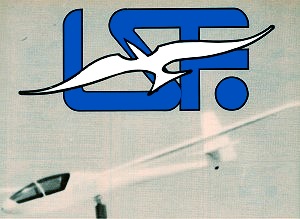 Way back when soaring was in its infancy
on the West Coast, a group of hardy souls from the San Francisco area felt that
it would be a good thing to introduce to the world a fabulous way to get people
together for soaring fun. They organized the LSF. Way back when soaring was in its infancy
on the West Coast, a group of hardy souls from the San Francisco area felt that
it would be a good thing to introduce to the world a fabulous way to get people
together for soaring fun. They organized the LSF.
The League of Silent Flight was formed to provide a collective identification
for soaring enthusiasts throughout the world and to recognize their accomplishments
through a defined program of performance with RC model sail-planes. LSF was not
intended to be a club, but a group offering a chance for men and women to get together
in sporting and competitive soaring activity.
There are no dues in the LSF; you cannot buy your way into this group. You must
earn your way in and up through five levels by accomplishing a series of tasks which
increase in difficulty.
The first tournament of this elite unit was held in 1970 (Aug. 29-30, to be exact).
The Nelson family of full-size and model glider fame opened up their gliderport,
"Hummingbird Haven" in Livermore, Calif., to 85 contestants. The North and South
Bay Soaring Societies cosponsored the meet. Les Anderson walked away with the No.1
spot in the No.1 contest.
In 1971, more than 100 SFers returned to Livermore for a second year. Would you
believe that there was a five-way tie for first, until Rick Walters nosed out John
Donald-son? Le Gray astounded the group with his rare wit and dry humor at the banquet.
That is probably what got him elected the second president of LSF, following the
able administration of Bob Andris. A new club appeared on the scene that year, represented
by 12 members who drove all the way from San Diego to see how the big boys flew
sailplanes. They were called the Torrey Pines Gulls.
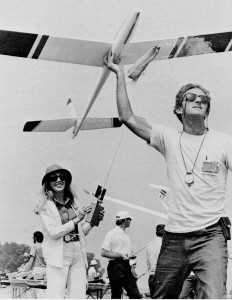
The half CDs in a more relaxed moment. At the Chicago S.O.A.R.
Nats, Dick launches Barbara's Cirrus. (Photo by Bill Coons)
In 1972, Women's Lib was becoming the big thing and Barbara Henon liberated the
big hardware. Barbara's Club, the San Fernando Valley Silent Flyers, ably handled
the organization of this meet. This was the first meet to be held at the Mile Square
site in Fountain Valley, Calif. The winning club was from the North again, as the
South Bay Soaring Society took the laurels. Will the South rise?
1973 was the year for the South. The Torrey Pines Gulls took the Chicago Soaring
NATS team award with Rod Smith, Mark Smith and Col. Bob Thacker. Then August rolled,
around, and it was LSF Tournament time again. Camarillo, Calif., was the host city,
and the LSF had the entire Oxnard Air Force Base. This was the first time that speed
was the big thing, and 8-10 lb. monsters were the rule. The little 5-6 oz. wing
loaded (Standard Class) gliders should have stayed home. The Torrey Pines Gulls
came to prove that they were big boys now. They won the first three positions and
the team award. Buck Faure, the Gulls' president, was No.1 (King Golden Thumbs,
as his daughter christened him). The Camarillo Flying Circus had this one as the
best team. Who will forget the mountain of barbecued ribs we consumed at the banquet-Sunday
between flights it was Rolaids, Turns, Bromo and Alka Seltzer.
Here it is, the Fifth Annual LSF Soaring Tournament back at Mile Square,
which in now under the control of the Fountain Valley, Calif., Parks Dept. For
the first time, we had to pay for the privilege of admission to a soaring site.
The half-dollar wasn't too bad, but at least they could have had the toilets
less than three-quarters of a mile away. This tournament was hosted by a rather
new group on the soaring
scene, the Southern California Soaring Clubs, fondly known as SC2. It is Aug. 24-25
Mark!
Winch lines whip off silent sail-planes, now freed to fly-timed-fly.
Mark!
Stopwatches snap at speed traps as soarers slither through the sunshine-timed-
fly.
Mark! the timer cries. "Mark your mark and make your target."
The hurly burly contest ,like slow motion-silent flight. Here in leagues, they
fly-League of Silent Flight.
Mark! they cry. MARK! they fly.
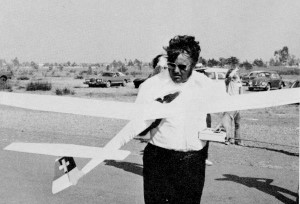
Hugh Stock checks the controls of his scale Diamant. (Photo by
Chris Adams)
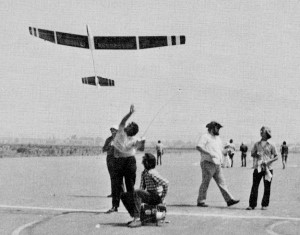
Lemon Payne launches his Legion Air. (Photos by Paul Denson)
Five score of pilots participate on the square mile of asphalt (circles on asphalt
for soft landings)-"Slide an inch or slide a mile" says Schilling, half CD, while
other half ... the Henon half. .. draws diagrams on the chalkboard during the pilots'
briefing-briefly all evening it took to register and be briefed. Why? Lots of questions.
Must be sure, for sure, for this is a biggie-a tournament-the LSF Tournament. The
mile (I'd walk a mile for a thermal) squares off against the soaring scores, while
scores of soarers score ... hit the
MARK!
"And who flew?" asks the chorus. There was Rick Walters (Super Trash elliptically
tipped), and Lemon Payne (Legion Air-superb new kit). and Rod-man Smith (with Willow-Bee
Wand in hand), and V-tailed Dale Nutter, and straw-hatted Col. Bob Thacker, and
frumpy-hatted Dave Shadel, and of course, the man (and here he is folks, fresh from
the S.O.A.R. Nats and AerOlympics) ....
Mark.
And me, I flew too.
And curly haired dawn slumbered not long in her haste to spread light upon the
firmament ... exactly a mile square of it. When 10, came the metal chariots carrying
warriors (pugipilots) into the recreation center (a mile square arena) where gladiatorially
they toted slender weapons which penetrated the air like machines of the gods. But
what holds them back? Why tarry, brave men, bird men? Do they heed the Icaran warning
with the rosy-fingered sun still so low?
Schilling, half CD, scurries helter-skelter with seine line slipping every-where.
He turns around, all akimbo, while the turnarounds fail. The auto mechanic acts
instinctively and, before you can turn around, the turnarounds are fixed.
MARK! they cry, as the warriors fly.
"An aside from our on-the-spot correspondent. What? Not there yet? Still
sleeping! . Stay tuned for an in-depth analysis a little later in our program."
And me, I flew, too ... after I awoke, later.
Now Zeus breathed life into the air (a square mile of air) and the lower gods
(deities of the thermal) settled low up-on the plain (and planes) of war and oversaw
the combat. And Dale of the Nutter did drink with the gods' cup and was justly rewarded
with a MAX.
MAX/(macks) noun (abbrev.), a maximum score. Defined at the LSF contest under
two categories. 1. A MAX of 10 minutes, by which the flier, or pilot, sustained
flight with his aircraft for ten (10) minutes, after which a landing period of three
(3) minutes was al-lowed. Cf. AMA task II. 2 A MAX of three (3) minutes, by which
the flier, or pilot, maintained flight with his aircraft for three (3) minutes from
time of tow release ...
MARK!
... until the aircraft made initial con-tact with a ground-based object. See
also: Object, ground-based.
Q. And who else may have, given the hypothesis that a maximum flight duration
of ten (10) minutes was possible on Saturday Aug. 23, 1974 (during the hours of
9:30 and 3:00 p.m.), achieved the distinction of flying a MAX (use the dictionary
definition of MAX)? Answer worth 25 points.
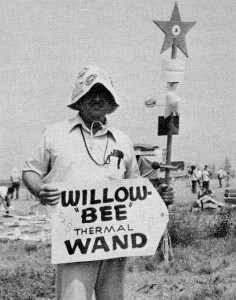
Yes, Virginia, there is a thermal fairy.
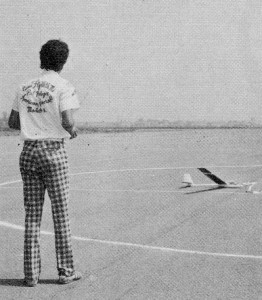
Me, too, I flew. (Photo by Paul Denson)
A. To repeat all the names would be moribund. We can achieve an equitable realization
of the factors, species and other things involved in winning the LSF Tournament
only by citing a few significant names. These would be (not necessarily in any order):
D. O. Darnell, Dale Nutter, Max Mills, Terry Malsbury and Smith.
Mark?
No. Rodman maxed.
By this time, the Olympiad sat silent, while silent flight occurred.
&
"And now, an interview by our crack reporter, who has just collared Schilling,
half CD."
"Testing, one, two, three. Hello, glider guiders everywhere. Today we're at Mile
Square Recreation Center in sunny Southern California. Dick Schilling, who, along
with Barbara Henon, is co-Contest Director of this meet, is here with me. Hello
Dick."
"Hi Pat."
&"Dick, why did you opt for 10 minutes plus Duration and not the normally
preferred task of 10 minutes on the spot?"
"When you're flying Precision, you're flying Precision. When you're flying Duration,
you're flying Duration. The landing was the tie-breaker."
"As you all know, the landing circle out here is a 25·foot circle with a Mil
secured in the middle. TWQ measuring tapes are marked in points ... highest points
closest to the nail. When you land, you measure with the tape, then get your glider
out of the circle.
"Here's Mark Smith. Let's try to get a word with him ..."
Fair Zeus' rays shone now high in the heaven, as ...
"We've lost contact with our crack ... "
the combatants added heavy objects to their vehicles, to make them more like
Theban missiles. And they stood at the gates ...
"reporter. Stay tuned for further reports. "
raised flags and shouted. Like winged Mercury they flew ...
MARK! the stopwatches clicked as the Speed Event began. This year, no monster
KA6Es were present, each contestant apparently realizing the consequences of a.
poor trade-off in the all-important tasks of Duration and Precision.
"We interrupt this program for a candid interview with Mark Smith, which
was previously interrupted."
" ... think of the Speed Event."
'Well, Pat, the Speed Event simulates wind. It makes the winning airplane an
all-around design. If you just had a straight 10·Minute Duration with a bonus landing,
most obviously the best 'airplane would have a very, very large wing area; very,
very slow sink rate, and to heck with the LID. It would be all sink rate - the slowest
airplane to the ground would be the winner.
"So, if you had a person like Konrad Nierich who goes very, very fast all the
time; well, his model (the Tern, as published in July AAM) has a good LID but the
sink rate's bad. So, when the wind blows he has a very distinct advantage over the
Olympic-type air-planes, which have very poor penetration. So, when you throw the
speed in there, it makes the airplane become an all-around airplane-fly good in
wind, fly good in calm, and if the wind doesn't blow, the Speed Event creates the
wind.
"How much ballast weight are you carrying for the Speed Event?"
"Twelve oz., which brings the total weight of my Windfree to 42 oz."
.... like zephyrs across the course, both toward the sun and back, the glint
as they turned like fire on steel weapons in the air.
MARK! The Speed Event had just about concluded. Smith's time was the fastest,
at 38 sec., with Rick Walters only a second behind. Lemon Payne was in the low 40s
and ...
Yes, me too, I flew fast! Beginner's luck, since I was so green to this event
(my first try at it) that I had to have someone explain what I was supposed to do
when I got off the line.
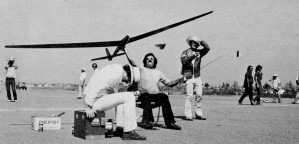
Buck Faure, the defending LSF Tournament Champion, couldn't get
his stuff to-gether this year. His PRESBYTERIAN design, so successful last year,
will appear in a future issue of AAM. (Photo by Chris Adams)
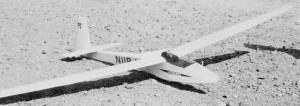
Don Edberg flew a Duster in Scale. A new kit from Airtronics.
(Photo by Chris Adams)
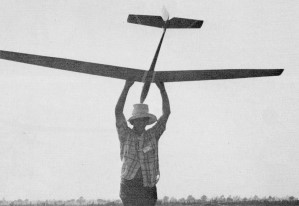
No, not with sailplane raised in victory, but rather a great
catch of Pat Seal's Cirrus, which looped off the line. Fast reflexes! (Photo by
Chris Adams)
Q. If you were Dick Schilling, half CD, how would you define the term, "creative
sandbagging?"
A. If I were Dick Schilling, half CD, I'd define the term, "creative sandbagging"
by example. On Saturday, a certain well-known flier, with full know-ledge of the
rules for the Speed Event, which specifically stated that, once off the line, the
plane was to make an immediate 1800 turn (and not attempt to ride any lift in the
vicinity), then fly back over the winches, and lastly to make a 900 turn onto the
course, which was perpendicular to the towlines, utilized "creative sandbagging."
Upon encountering up air off the tow, he made his 1800 turn more a shallow slip-ping
affair, which enabled him to fly with his maximum LID in the thermal and slowly
drift back (still in the thermal) into an advantageously high position from which
to start his speed run. That's "creative sandbagging." Dick Schillinq, half CD,
expressed his admiration for this sort of thing, since it takes talent. Mr. Schilling
and Ms. Henon ran the LSF Tournament in a wonderfully relaxed style, with no pressure
on the fliers. This made it a really enjoyable contest.
"Well, the day's flying is over. This is your crack reporter signing off 'til
tomorrow morning."
Dateline: Sunday, Aug. 24, Mile Square Recreation Center, Fountain
Valley, Calif. Today, the LSF entered its second day of formal competition. With
125 contestants, the Tournament is second only in size to the Chicago S.O.A.R. Nats.
"And we now return you to our crack reporter. What's that? Still sleep-ing!
Stay tuned for bulletins as they happen."
And rosy-fingered dawn stretched out her soft fingers through a veil of haze.
Their weapons in strong lines on the ground, the warriors stood ready to resume
their battle. No champions stepped forward yet, and each man looked quietly toward
the hazy sky.
EDITORIAL
The position of this publication, like that of any news media, is that it is
the primary function and responsibility of the press to be a critic, and often the
adversary, of government. And, in years past when we felt something was wrong, we
stated our opinion.
It is imperative that we must, at this moment, give pause for a thought which
will have ramifications throughout the soaring world. Our topic is the proper definition
of team entries in a contest of the caliber of the LSF Tournament. Reliable sources
inform us that the winning team was not, as one would expect, made up of individuals
who were members of the same AMA-chartered club. Regrettably, the first-place team
consisted of three individuals who decided to make themselves a team entry only
shortly before the contest began.
Even more appalling is the fact that at least four of the other so-called "teams"
were not composed of individuals who were affiliates of a recognized club, but rather
what we must assume to have been convenient alliances of compatible (and, of course,
skilled) fliers. This is wholly out of the accepted context of team competition
and it is hoped that the LSF, or the CDs for the '75 Tournament, give serious consideration
to regulating closely the requirements for a team entry.
MARK!
Sailplanes were a-flying now, the tarmac aglow with pretty rays of soft sun.
Thermals afoot across the towlines, like silent bubbles. All was sweetness and harmony
in gliderland.
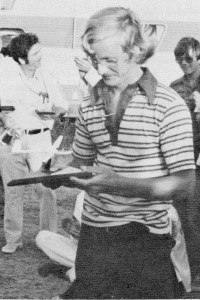
Mark Smith! (Photo by Chris Adams)
"In retrospect, our object in the con-test was to have a contest where skill
would count, where the best fliers would win, and where luck wouldn't count.
"I think that the contest ... the way we designed it, the best fliers came out
on top." Quote from Dick Schilling, half CD.
MARK!
"And here's our crack reporter, awake and aware."
"Hi there!"
By now, all fliers had completed their 10-Minute Duration and Three-Minute Precision.
Jim Wiseman pretty well had Precision in the bag, while Oklahoma Dale Nutter V-tailed
it into the top spot in Duration .
What about Standard Class?
The magazine litany of the winners:
Precision
Rick Pearson Dave Thornburg Richard Barker
Duration
Rodman Smith (the Father) Max Mills
Terry Malsbury
Amen.
"Hello, there!"
Speed got off at 3 o'clock.
A perfect score folks! Rick Walters (Remember him from Paul Denson's preface
above?) astounded the sports world, as well as a few modelers, by zinging a stupendous
2000 points in Speed (calculated at 39 and 40 sec. on the timers' watches ... Mark!)
Lemon Payne flew that lightly loaded (5 oz. sq. ft.) Legion Air fast enough through
the traps to secure second place .
And third place was captured by ... Me too, I flew!
"Hi there! Mark my words, I'm here awake and aware to tell you about the Scale
sailplanes. I timed a beautiful flight for H ugh Stock, the eventual winner. His
Diamant (a SoarCraft kit, of course) was launched into some tricky air. There was
a long-standing thermal to the left of the runway and about a quarter of a mile
out. Hugh got off the line ...
'''Mark: I shouted.
" .... and headed for the leftward lift.
"After only about three min., the lift started to get sketchy, and Hugh, with
my verbal assistance, opted for what looked like a good piggyback spot to the right
of the runway.
"Yes, he was getting pretty low, too ... maybe only 400 feet or so. Across the
sink he slid, losing more ground in an attempt to get to the lift. Those blokes
were really pretty far out, maybe even to the edge of the field, and Hugh was getting
really low by now. As he crossed the edge of the runway, some minor lift was encountered.
"Now only at maybe 200 feet, things didn't look so good for Hugh's Diamant. He
flew really well, though, in the spotty lift, and soon the halfway point (five min.)
was passed. But another full five min. from 200 feet in thermals so small that turning
inside them was impossible?
"But mustached, amiable Stock is a real champion, and he flew that sail-plane
as smoothly as a greased billiard ball on a pool table.
"Finally, hearts in throats, the Diamant was so low that the cockpit detail was
starting to show ... and there were still two min. left. At almost nine min., there
just wasn't anymore lift to be had, and H ugh came in for a good landing off to
the side of the runway. (No precision landing at all was required for the scale
models. After all, why jeopardize them on the concrete?)
"When all was said and done, Hugh emerged victorious, with 14,034 total points;
163 static and 1722 flight points.
"D. O. Darnell was second by only eight points with his Glasflugel 604, and Lee
Renaud flew his attractive new Duster design (soon to be an Airtronics kit) to third
place.
"And that IS what happened in Scale."
As our crack reporter rides off into the sunset, the 1974 LSF Tournament is at
an end.
"And who won the title of LSF Tournament Champion," asks the chorus.
Mark!
Posted April 16, 2022
|


